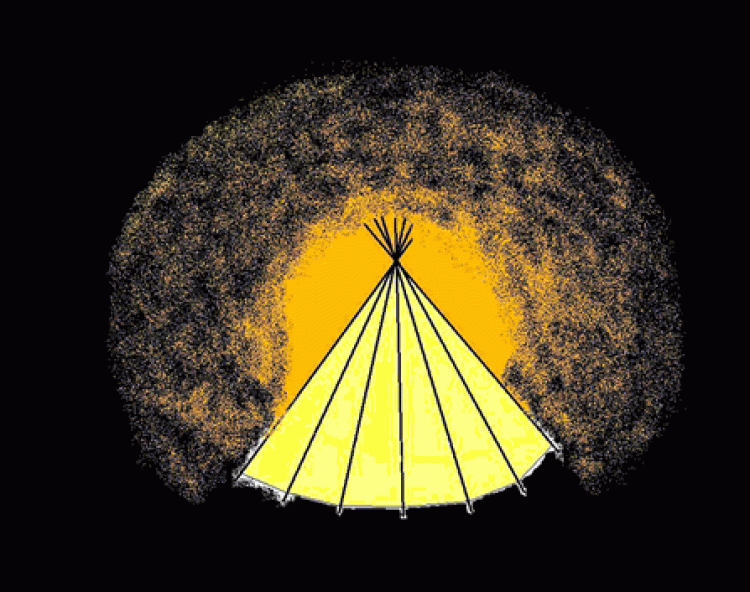Sacred Rituals

The Arapaho name for the ceremony is hoseihoowu' . This word means roughly 'give away lodge.' The Arapaho do not really worship the Sun during this ceremony. Rather it is a time of prayer and sacrifice to the powers above. The individual who sponsors the ceremony normally does so in order to restore health to some member of his family, and to the Tribe more generally
The Sun Dance occurs during the summer time, typically in the months of July and August. There is no set date. The complete ceremony lasts seven days, of which the last four days involve the actual dancing.
Although the Sun Dance has been described by anthropologists in the past, the Arapaho no longer allow photographs to be take, drawings to be made, or notes to be taken at the Sun Dance. It is their most sacred ceremony, and these restrictions are respected on this website. On this page, we offer some general information only.
The Sun Dance is not a tourist event. Neither the Arapaho nor the local people of Wyoming promote it as such. It is done by the Arapaho for the Arapaho people themselves. If you would like to visit the Reservation and see dancing, a powwow is probably the best event to attend. Powwows are much less religious, and are attended by many different people from all over. They are promoted by the organizers, and many vendors are present, so attendance is actually desired and encouraged for all people who are interested. There are powwows at least twice a month usually during the summer.
The Sun Dance is not closed to outsiders, however. One may attend and watch, provided one is respectful and obeys all the rules and restrictions in place at the event. A fair number of non-Arapahos do usually attend the event. Many of these are members of other Native American tribes, who enjoy attending other tribes' ceremonies. Some non-Indians do attend as well, mostly as guests of the various Arapaho families. People without connections to the Reservation or without knowledge of such ceremonies may feel uncomfortable at times.
The Sun Dance is held on the Wind River Reservation in Wyoming . Many Southern Arapahos from Oklahoma come up every summer to attend as well, and to visit with their relatives from the north. Sun Dances were once held in Oklahoma as well, but this is no longer done.
The Peyote Ceremony, often associated with the Native American Church, consists of a mix of native beliefs and practices along with Christian symbolism. God, Jesus, and Mary are offered prayers in addition to the peyote. Peyote allows members of the Native American Church to seek and obtain wisdom. It is also considered a sacred medicine. When a member of the tribe seeks the peyote, he receives characteristics that are part of the cactus, rebalancing with nature.
Song and ritual are very important in the ceremony. Songs help the Arapaho receive the emotional, physical, and intellectual properties of the peyote. To begin, the leader, sings the opening song, while the man wit the peyote drum keeps a rapid, even drumbeat and sings along at his right. To the left of the lead, sits a man with a cedar branch. Moving clockwise, the drum and rattle are passed from one person to another, each of them singing the four ceremonial songs. Throughout the ceremony, groups of four songs are sung by every person present: Opening Song of the Peyote Ceremony, Midnight Song, Daybreak Song, and Closing Song. Rhythm and song texts of the peyote songs are simple and melodic. The rhythm of the songs is basic with count divisions chiefly composed of quarter and eighth notes. Vocables, paired phrases, make up the song texts of peyote, ending in "he ne ne yo way."

